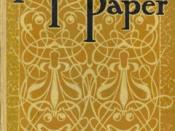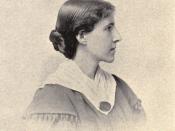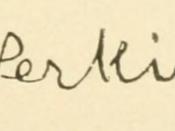Although most people will find The Yellow Wallpaper as simply an account of a woman that sunk into deep depression, it is possible to extricate dual interpretations from this story. There is one meaning that is describing that the author, Charlotte Perkins Gilman can be related to the female in the story; this is achieved by comparing the author's life and her character's life piece by piece. One might find that The Yellow Wallpaper is very similar to events that actually took place in the author's life. On the other hand, the more popular theory of the two states that many individuals examine this story from a feminist point of view. By this, I mean, they read and translate this story with a critical perspective, a view that generalizes men as chauvinistic and domineering.
Charlotte Perkins Gilman was born in Hartford, Connecticut, the daughter of Frederick Beecher Perkins, a librarian and writer, and Mary (Westcott) Perkins.
Among her father's forebears was the novelist Harriet Beecher Stowe, his aunt. Perkins abandoned his wife after their infant died in 1866 - Mary Perkins lived with her children on the brink of poverty and was often forced to move from relative to relative or to other temporary lodgings. Charlotte Perkins Gilman was an avid reader and largely self-educated. She studied two years at Rhode Island School of Design (1878-80) and then earned her living designing greetings cards. In 1884 she married Charles Walter Stetson, an aspiring artist. After the birth of their daughter Katharine, she was beset by depression, and began treatment with Dr. Silas Weir Mitchell in 1886. His recommendations, 'live as domestic a life as possible' and 'never touch a pen, brush or pencil as long as you live' Gilman later satirized this in her autobiography, and used the discussions...



The Yellow Wallpaper
It was a pleasure to read your good essay on Charlotte Gilman's powerful story. Since one interpretation of The Yellow Wallpaper is that it is semi-autobiographical, the background information about the author which you gave was appropriate. You did well to illustrate how the metaphors, images and plot of this story underlay its meanings. Your report was well researched and skillfully presented. The bibliography will be helpful to those who wish to do further reading about the story and its author. Thumbs up!
6 out of 7 people found this comment useful.